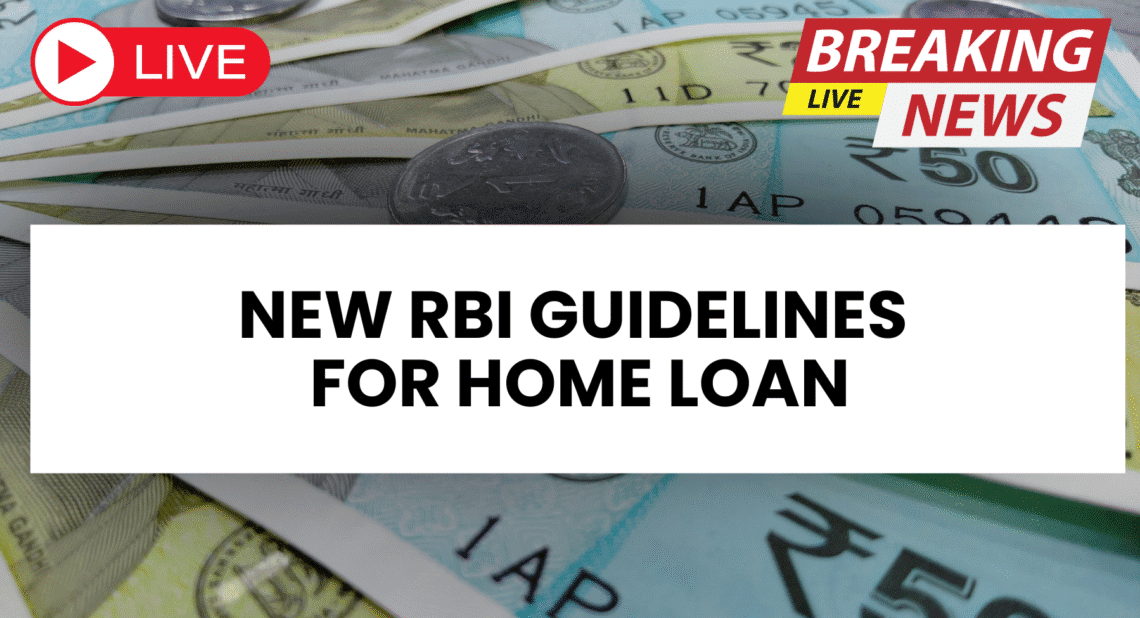Dreaming of buying your first home but worried about high EMIs and complicated loan procedures? You’re not alone. For years, Indian homebuyers have struggled with rising interest rates, confusing paperwork, and rigid repayment structures that often made homeownership feel out of reach.
But in 2025, the Reserve Bank of India (RBI) has changed the game. The central bank has rolled out a fresh set of home loan guidelines that aim to make housing more affordable, accessible, and stress-free.
With lower home loan rates, greater repayment flexibility, and simplified documentation, the new rules are designed to benefit everyone—from first-time buyers to salaried professionals and self-employed individuals.
Let’s break it down.
Table of Contents
What Do the New RBI Guidelines Say?
The 2025 RBI home loan framework revolves around three key areas:
1. Simplified Documentation
Banks and housing finance companies are now required to:
- Minimize unnecessary paperwork
- Provide clear instructions for applicants
- Avoid hidden charges or confusing terms
👉 This makes the process faster, smoother, and transparent.
2. Flexible Repayment Options
Borrowers can now:
- Choose EMI plans tailored to income cycles
- Opt for step-up EMIs (lower in the beginning, higher later as income grows)
- Use part-payment options to reduce outstanding loan amounts
- Pick repayment schedules that match weekly or seasonal incomes (ideal for freelancers, gig workers, and self-employed).
3. Lower Interest Rates
Banks have been instructed to offer competitive rates, bringing effective home loan interest down.
- This reduces the overall loan cost.
- EMIs become more affordable.
- Families gain financial breathing space.
Major Benefits for Home Loan Borrowers
Here’s how the new RBI guidelines make a difference:
✅ Reduced Financial Burden
Lower interest rates = smaller EMIs. This allows families to manage daily expenses, healthcare, education, and savings more comfortably.
✅ Greater Flexibility
Borrowers can pick repayment options that match their income flow. No more stress of rigid monthly EMIs if your earnings fluctuate.
✅ Faster Loan Approvals
Simplified paperwork means quicker approvals and faster disbursal of loans.
✅ Transparency
Banks must ensure borrowers are aware of all charges upfront—eliminating hidden costs.
Impact on Monthly EMIs
Let’s take a practical example.
Suppose you take a ₹40 lakh home loan for 20 years.
| Interest Rate | EMI per month | Total Payable |
|---|---|---|
| Old Avg. 9% | ₹35,990 | ₹86.3 lakh |
| New Avg. 7.5% | ₹32,112 | ₹77.1 lakh |
👉 Savings = ₹3,878 per month and ₹9.2 lakh overall.
For middle-class families, that’s a huge relief.
Boost to Home Ownership in India
One of RBI’s core objectives is to encourage more people to buy homes.
Who Benefits the Most?
- First-time buyers → Affordable EMIs make ownership possible.
- Salaried employees → Predictable income matches flexible repayment.
- Self-employed & freelancers → Can align repayments with irregular earnings.
- Middle & lower-income groups → Gain access to housing with reduced strain.
By making housing finance more accessible, RBI is not just helping individuals—it’s also boosting the real estate sector and economic growth.
How to Avail These Benefits
Thinking of applying for a home loan in 2025? Here’s how to make the most of these new rules:
1. Compare Loan Offers
- Don’t just go with your salary account bank.
- Check interest rates, processing fees, and repayment flexibility across lenders.
2. Maintain a Good Credit Score
- RBI’s borrower-friendly rules still favor those with strong credit.
- Aim for a CIBIL score of 750+ to get the best rates.
3. Prepare Accurate Documentation
- Keep ID proof, salary slips, ITRs, and property papers ready.
- Inaccurate documentation = delayed approvals.
4. Discuss Repayment Options
- Ask about step-up EMIs, part-payments, and balance transfers.
- Customize repayment to avoid future stress.
Impact on the Real Estate Market
Experts believe these guidelines will:
- Increase housing demand across metro and tier-2 cities.
- Boost sales for affordable housing projects.
- Support construction jobs and allied industries.
This move aligns with India’s long-term vision of “Housing for All.”
Pros & Cons of the New RBI Guidelines
✅ Pros
- Affordable EMIs
- Flexibility for self-employed workers
- Transparency in charges
- Quicker loan approvals
⚠️ Cons
- Banks may still set slightly higher rates for risky borrowers
- Real estate demand surge could raise property prices
- Borrowers with low credit scores may not see the same benefits
FAQs on RBI’s New Home Loan Guidelines 2025
Q1. What is the new RBI home loan policy for 2025?
It focuses on lower interest rates, flexible repayment, and simplified documentation.
Q2. Will my existing home loan rates reduce automatically?
If your loan is linked to a floating rate, yes. Fixed-rate borrowers may need to refinance.
Q3. Can freelancers and gig workers get loans easily now?
Yes, banks must offer flexible repayment structures based on irregular income.
Q4. How much can I save on EMIs with the new rules?
On a ₹40 lakh loan, you can save nearly ₹4,000 monthly.
Q5. Do all banks have to follow these guidelines?
Yes, all RBI-regulated banks and housing finance companies are required to comply.
Q6. When do these new rules come into effect?
They apply from 2025 onwards, as per RBI’s circular.
Q7. Will this push property prices up?
In high-demand areas, yes—cheaper loans may boost demand, raising prices slightly.
Conclusion
The RBI’s new 2025 home loan guidelines are a game-changer for aspiring homeowners. By cutting interest rates, simplifying paperwork, and introducing flexible repayment options, the central bank has eased one of the biggest financial decisions for Indian families.
For individuals, this means lower EMIs, faster approvals, and stress-free ownership. For the economy, it means a boost in housing demand, stronger real estate growth, and greater financial inclusion.
👉 If you’ve been waiting to buy your dream home, now may be the perfect time to apply under the new RBI framework.





